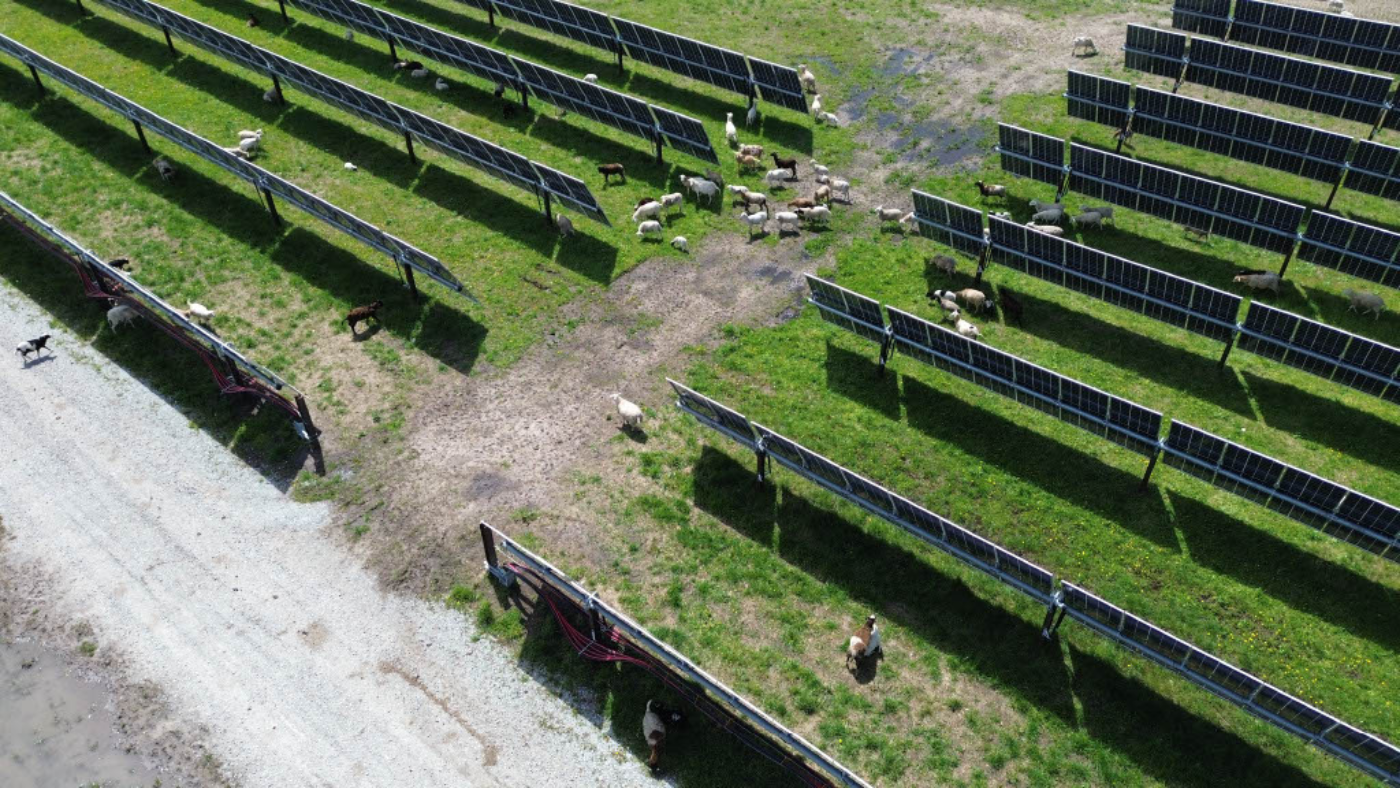
Sheep graze around solar panels at the first phase of the Mammoth Solar project — which is already up and running in northwest Indiana and generating enough energy to power around 75,0000 homes. The next phase of the project will go online next year, and once completed, Mammoth will be one of the largest solar projects in the United States. (Image: Doral Renewables)
Solar industry advocates are facing new hurdles at every level of government, from local town halls to the White House. But the economic case for solar energy can help developers win community support, regardless of political affiliations. The new Mammoth Solar project in the red state of Indiana is one example. In addition to building support for solar development among local residents and farmers, the project also aims to showcase how the emerging field of agrivoltaics can benefit farmers elsewhere in the state and around the country.
The agrivoltaic solution to land use conflicts
Solar developers lease farmland for utility-scale solar arrays because the parcels are large, relatively flat, exposed to sunlight and devoid of trees. Access to existing roads and transmission infrastructure is another benefit.
But that practice has raised fundamental land use conflicts, especially in the initial years of solar development. Solar panels were relatively expensive in the early 2000s, leading developers to cut corners where they could. In a typical solar array, the panels would be mounted on the shortest possible racks, perched above a bed of sand, gravel or other low-maintenance ground cover.
Under those conditions, solar panels cast too much shade for any crops to grow beneath the array. However, by 2018 evidence began to emerge that some plants thrive in partial shade while the panels also support soil health by cooling the ground and reducing water evaporation. Those findings spurred the establishment of a new field of research called agrivoltaics or agri-PV.
In recent years, the cost of solar panels has continued to drop, providing developers with more leeway to experiment with different racks and new solar cell technologies that allow more sunlight to reach the plants below. Some farmers are now experimenting with food crops, though pollinator habitats, native species restoration, and grasses for grazing livestock — aka “solar grazing” — are the most common dual-use projects to date.
Scaling up for more solar energy with farming
Despite the recent increase in activity, agrivoltaics remains a niche field. For good reasons, farmers are reluctant to embark on new or unproven practices, all the more so under the current environment of disruptive trade wars initiated by U.S. President Donald Trump.
Still, surveys show that farmers are receptive to utility-scale solar projects that are based on agrivoltaic principles. Last year, for example, the Solar and Storage Industries Institute registered an approval rating of up to 70 percent among farmers for agrivoltaic projects. In the same survey, the organization also found that farmers who oppose solar development were less likely to be informed about agrivoltaic solutions.
One of the missing pieces is a large-scale showcase for successful agrivoltaic practices, and that is what the Mammoth Solar project in Indiana aims to provide. The sprawling 1.3-gigawatt solar array was designed from the ground up to incorporate farming.
The first phase of Mammoth broke ground in 2022, and the project soon caught the attention of agrivoltaic advocates. In July of last year, it won the inaugural Dual Use Plan of the Year award at the first annual North American Agrivoltaics Awards ceremony.
The project is “supported by significant investments in science, agronomy, and local farming communities,” says the company behind Mammoth Solar, the Pennsylvania-based renewable energy developer Doral Renewables. "By integrating renewable energy generation with agricultural practices, we are not only providing clean energy but also promoting heritage farming," Ed Baptista, Doral Renewables director of development and agrivoltaics, said in a press statement.

The next phase of the project includes land leased by 65 individual farming families and will utilize local materials including 20,000 tons of steel produced in Indiana. “The project is also expected to contribute over $40 million to local municipalities through taxes and economic development payments,” according to the company. The phased-in project, located in Starke and Pulaski counties in northwest Indiana, is scheduled to be fully up and running in 2026.
In alignment with the current state of agrivoltaic research, the Mammoth Solar project is hosting approximately 2,000 head of grazing livestock including sheep, alpacas and donkeys. It will also serve as a test bed for other agricultural products including corn, hay, melons, blueberries and honey. “Additionally, the project has tied some of its power purchase agreements to pollinator habitat commitments within and around the solar field, promoting biodiversity and sustainable farming,” Doral noted.
The economics of agrivoltaics
Even with local buy-in, farmers and agrivoltaic developers have to balance revenue between generating electricity and growing crops or livestock. An agrivoltaic array typically generates less electricity than a more tightly packed, conventional array in the same space. The loss of electricity revenue could be balanced by solar grazing or crop production, but farmers need to know how to assess that balance before committing to a project.
A research team in Germany has been developing a solar-plus-farming calculator to help farmers measure land optimization, and the Mammoth Solar project adds to the knowledge base by demonstrating best practices for managing an agrivoltaic project.
On Monday, Doral announced that it has selected the leading global solar operations manager NovaSource to run all major aspects of the project, including regulatory compliance and grid integration, deploying its advanced monitoring and analysis tools.
As for the political divide, when Doral held a launch ceremony for the project in October 2021, two top Republican state officials — Gov. Eric Holcomb and Secretary of Commerce Bradley Chambers — joined in support.
Under the Indiana constitution, Gov. Holcomb was ineligible to run for a third consecutive term last year, but Indiana’s loss is the solar industry’s gain. In March, Doral announced that Holcomb has been appointed to its board of directors.
In a statement announcing the appointment, Doral President and CEO Nick Cohen drew attention to Holcomb’s experience in economic development and community engagement in support of agrivoltaic solutions. While it remains to be seen if one person can make a significant difference, any step that can reduce the political friction is a welcome development as U.S. businesses continue to pursue the renewable energy transition.

Tina writes frequently for TriplePundit and other websites, with a focus on military, government and corporate sustainability, clean tech research and emerging energy technologies. She is a former Deputy Director of Public Affairs of the New York City Department of Environmental Protection, and author of books and articles on recycling and other conservation themes.














